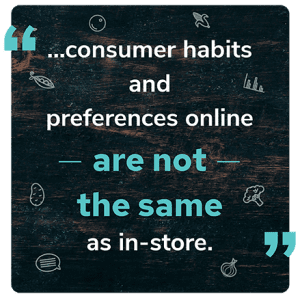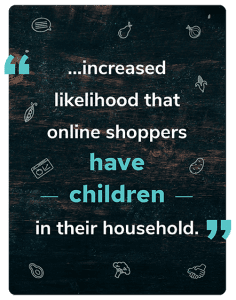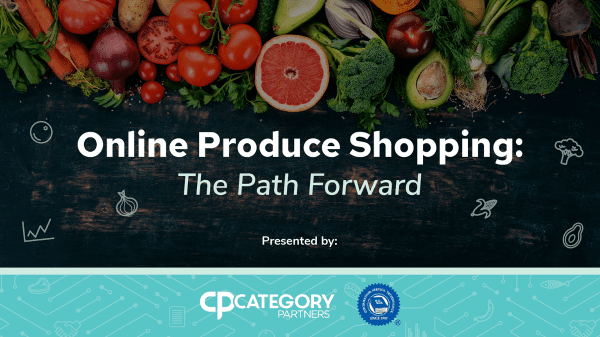Just four years ago, 10 percent of consumers surveyed by Category Partners reported buying groceries online, and zero percent said they went online to buy produce.
We’ve come a long way toward building trust with consumers, with a huge leap forward fueled by the COVID-19 pandemic, but that surge is showing signs of slowing, according to surveys conducted by Category Partners.
Now it’s time to step back and delve into who our online produce shoppers are, and their purchase intent.
Blue Book Services has teamed up with Category Partners to dig into the survey and help our readers understand what is happening, why it’s happening, and how they can attract consumers most effectively, in a series, Online Produce Shopping: The Path Forward.
The vast majority of consumers surveyed said they’re new to buying produce online. Seventy-three percent said they started just in the past 12 months, and while it is commonly reported that consumers don’t trust online shopping, the survey found that 82 percent said they would continue their online produce purchases. Just three percent said they didn’t plan to continue buying produce online, and 15 percent were not sure.
 When asked, consumers told us their top “Like” about online shopping was pandemic related safety. But “Likes” numbers 2 and 3, convenience and time savings respectively, are motivators that are not COVID related and represent a significant opportunity to retain online produce buyers.” Commented Lonnie Gillespie of Farm Fresh Direct BB #:286520, a study co-sponsor.
When asked, consumers told us their top “Like” about online shopping was pandemic related safety. But “Likes” numbers 2 and 3, convenience and time savings respectively, are motivators that are not COVID related and represent a significant opportunity to retain online produce buyers.” Commented Lonnie Gillespie of Farm Fresh Direct BB #:286520, a study co-sponsor.
But who are they? Category Partners found 47% of consumers in the west and 46% of consumers in the Northeast buy produce online. Sixty-nine percent of consumers ages 25-44 buy online, and 65 percent of consumers earning $100,000 or more buy produce online.
Online produce shoppers also tend to be city dwellers, rather than rural, with 65 percent living in a city with a population greater than 250,000. Parents also are more likely to shop for produce online than those without children. Nearly 70% of respondents with children in the home reported purchasing produce online.
It’s important to remember, however, that most consumers still prefer to shop in-store. Eighty-eight percent of online shoppers said they shop both online and in-store.
How do we satisfy both behaviors? Find ways for the in-store and online experience to complement each other, says Lonnie Gillespie of Farm Fresh Direct.
“Consumers tend to plan their online purchases and are a bit more likely to buy more physically durable categories, like potatoes, online. Marketers should look for opportunities to call out season starts and ends on their websites. The intent being to make that other seasonal fruit or vegetable more top of mind as they make that online potato purchase. We know most of those shoppers will be in-store to make purchases too.” Gillespie added.
It also pays to highlight new product launches both in-store and online.
“Eye-catching displays have been a successful product launch element for generations in-store. This method continues to offer value as consumers indicate they are more likely to buy on impulse in-store. With that in mind, consumers are spending ever increasing amounts of time online and looking for ways to streamline their shopping experience. Creating a dual channel strategy for product launches is essential. Marketers have to be very deliberate and almost intrusive online. You have to make it incredibly easy to notice your new items online.” said Cara Ammon, SVP of research with Category Partners.
Pack size also can differ depending on the way a consumer shops.
Online shoppers have consistently told us they tend to buy in greater quantity when shopping online. Maybe related is the increased likelihood that online shoppers have children present in their household.” added Ammon. “Be careful not to overcorrect. There are online shoppers who want the small pack sizes. But in general it is a good idea to make sure retailers have larger pack size offerings available online.” she concluded.
The data from this research suggests there are tactics available to retailers to retain online produce shoppers for the mid and long-term. …If the online channel is part of yours, or your customers’, competitive strategy. Consumers have tried and are open to permanent adoption provided they get the convenience, speed and quality and selection they expect.
About the surveys
Category Partners conducted an internet survey in May 2021 of 3,000 U.S. online produce consumers. The survey used a nationally-representative sample by region of the U.S.
Consumers were screened to include only shoppers who regularly shop for produce online.
Then, Category Partners conducted a second 3,000-respondent survey of the general population to determine how many U.S. shoppers currently buy produce online and which demographic groups are more likely to buy produce online. Category Partners was able to ask non-users why they do not shop online and what might get them to try online shopping.



